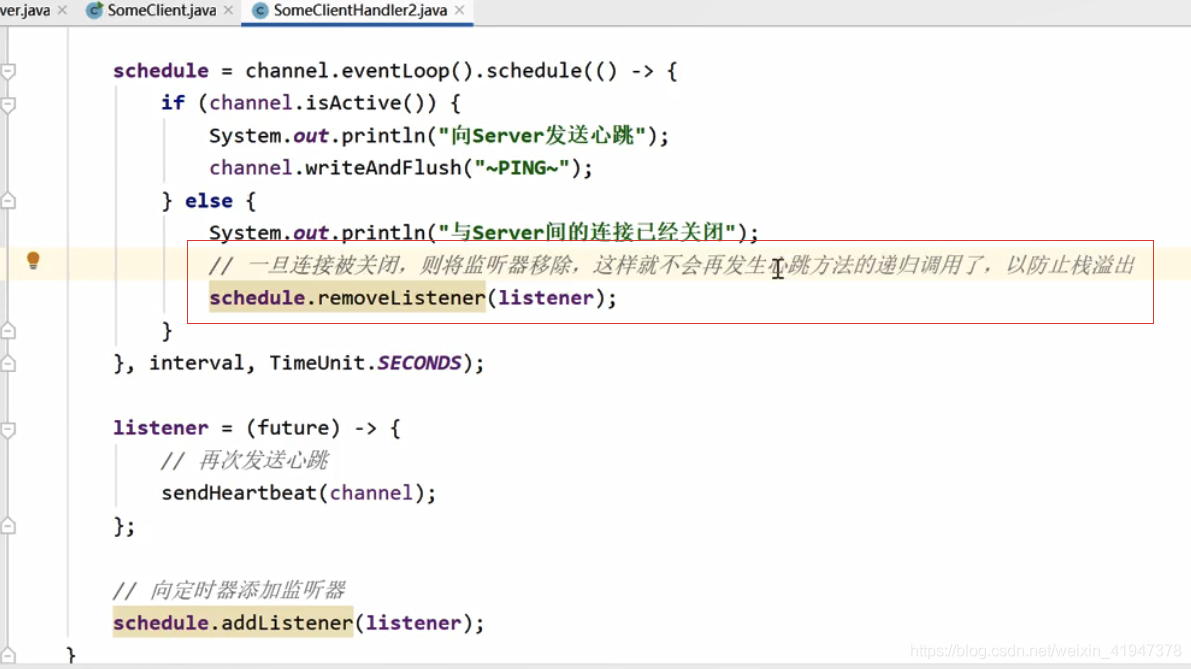Netty 高级应用
本章会通过代码实例的方式将 Netty 常见应用场景中的知识点进行讲解。
1. WebSocket 长连接
1.1 WebSocket 简介
WebSocket 是 HTML5 中的协议,是构建在 HTTP 协议之上的一个网络通信协议,其以长连接的方式实现了客户端与服务端的全双工通信。
HTTP/1.1 版本协议中具有 keep-alive 属性,实现的是半双工通信。
Http协议只能由客户端向服务端发消息,然后获得响应,而WebSocket可以实现服务端主动向客户端发送消息。
全双工通信(Full duplex Communication)是指在通信的任意时刻,线路上存在A到B和B到A的双向信号传输。 全双工通信允许数据同时在两个方向上传输,又称为双向同时通信,即通信的双方可以同时发送和接收数据。在全双工方式下,通信系统的每一端都设置了发送器和接收器,因此,能控制数据同时在两个方向上传送。全双工方式无需进行方向的切换,因此,没有切换操作所产生的时间延迟,这对那些不能有时间延误的交互式应用(例如远程监测和控制系统)十分有利。
半双工通信(Half-duplex Communication)可以实现双向的通信,但不能在两个方向上同时进行,必须轮流交替地进行。在这种工作方式下,发送端可以转变为接收端;相应地,接收端也可以转变为发送端。但是在同一个时刻,信息只能在一个方向上传输。因此,也可以将半双工通信理解为一种切换方向的单工通信。例如:对讲机是日常生活中最为常见的一种半双工通信方式,手持对讲机的双方可以互相通信,但在同一个时刻,只能由一方在讲话。
1.2 需求分析
在页面上有两个左右并排的文本域,它们的中间有一个“发送”按钮。在左侧文本域中输入文本内容后,单击发送按钮,会显示到右侧文本域中。
1.3 定义工程 05-websocket
复制 01-primary 工程,在此基础上进行修改:05-websocket
1.4 定义客户端页面
在 src/main 下定义一个目录 webapp。在其中定义 html 页面。
<!DOCTYPE html>
<html lang="en">
<head>
<meta charset="UTF-8">
<title>index</title>
</head>
<script type="text/javascript">
// 当前页面一打开就会执行的代码
var socket;
if(window.WebSocket) {
// 创建一个WebSocket连接
socket = new WebSocket("ws://localhost:8888/some");
// 当与服务端的ws连接创建成功后会触发onopen的执行
socket.onopen = function (ev) {
// 在右侧文本域中显示连接建立提示
var ta = document.getElementById("responseText");
ta.value = "连接已建立";
}
// 当接收到服务端发送的消息时会触发onmessage的执行
socket.onmessage = function (ev) {
// 将服务端发送来的消息在右侧文本域中显示,在原有内容基础上进行拼接
var ta = document.getElementById("responseText");
ta.value = ta.value + "\n" + ev.data;
}
// 当与服务端的ws连接断开时会触发onclose的执行
socket.onclose = function (ev) {
// 将连接关闭消息在右侧文本域中显示,在原有内容基础上进行拼接
var ta = document.getElementById("responseText");
ta.value = ta.value + "\n连接已关闭";
}
} else {
alert("浏览器不支持WebSocket");
}
// 定义发送按钮的发送方法
function send(msg) {
// 若当前浏览器不支持WebSocket,则直接结束
if(!window.WebSocket) return;
// 若ws连接已打开,则向服务器发送消息
if(socket.readyState == WebSocket.OPEN) {
// 通过ws连接向服务器发送消息
socket.send(msg);
}
}
</script>
<body>
<form>
<textarea id="message" style="width: 150px; height: 150px"></textarea>
<input type="button" value="发送" onclick="send(this.form.message.value)">
<textarea id="responseText" style="width: 150px; height: 150px"></textarea>
</form>
</body>
</html>
1.5 定义服务端
(1) 定义服务端启动类
如果只是支持WebSocket,只需要添加HttpServerCodes(http协议处理器)和WebSocketServerProtocolHandler(webSocket服务端协议处理器)两个处理器即可,WebSocketServerProtocolHandler需要传入参数指定WebSocket请求路径(顺序HttpServerCodes必须在最前面)
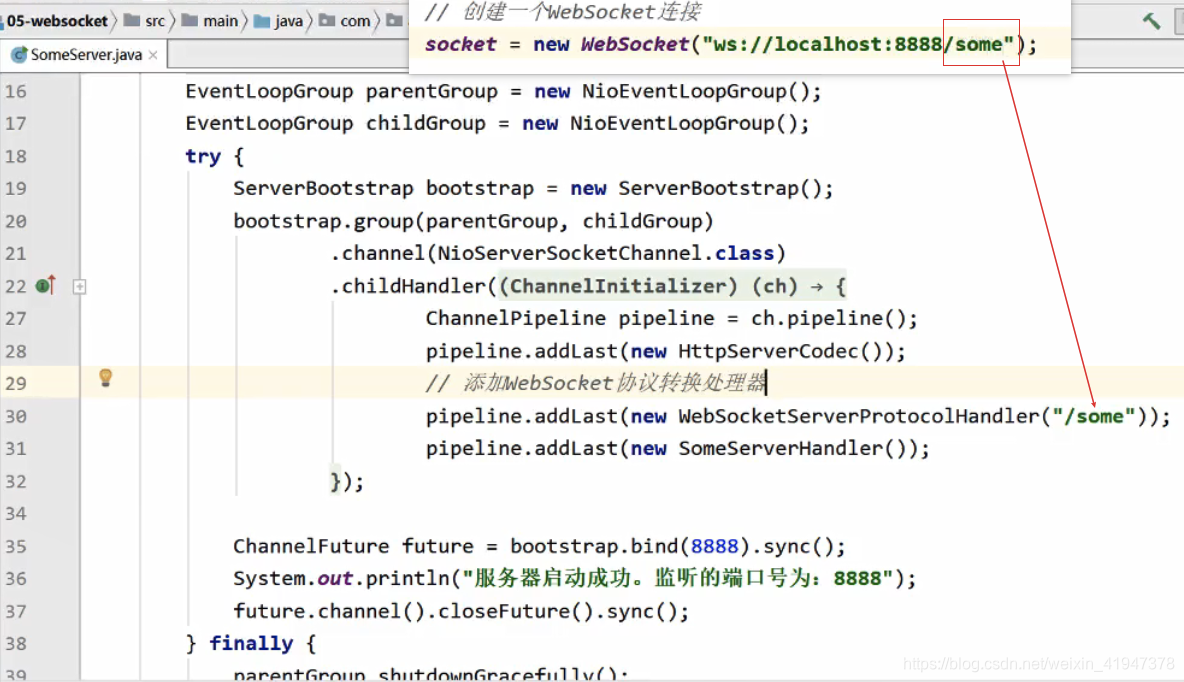
如果希望WebSocket连接,无论是客户端发给服务端,还是服务端发给客户端,允许传输比较大的数据,需要再添加一些处理器:
- ChunkedWriteHandler:大块数据Chunk处理器
- HttpObjectAggregator:Chunk聚合处理器
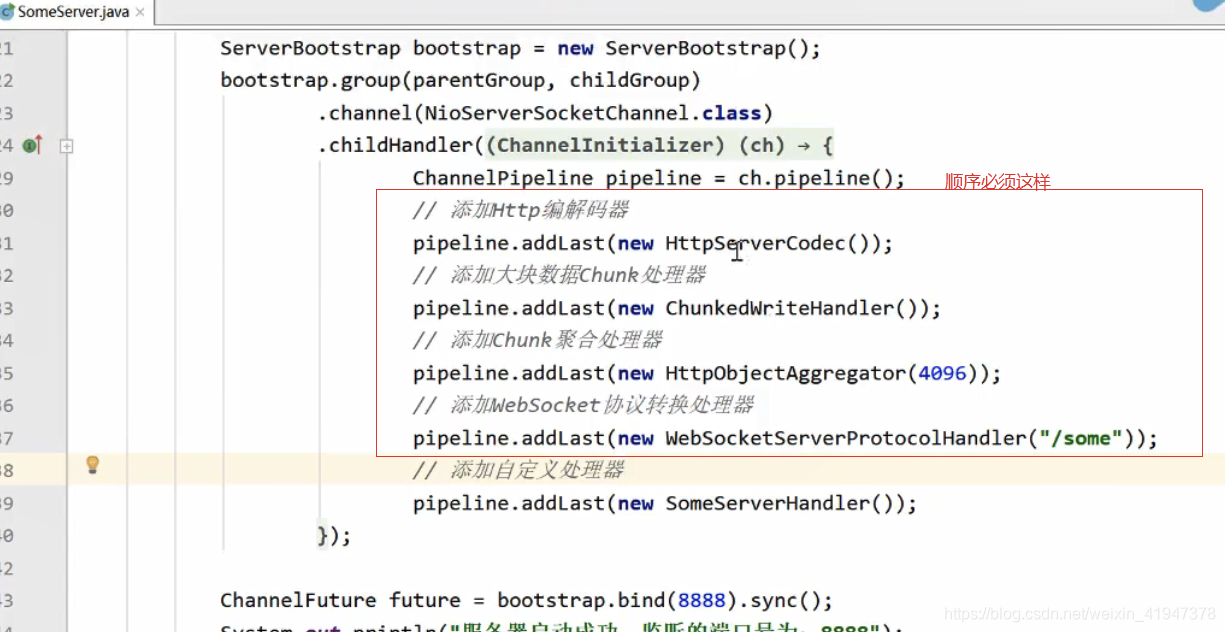
注意,我们需要了解几个核心类:
ChunkedWriteHandler:
这个类可以处理大数据流,而不用花费大量内存,也不会内存溢出HttpMessage:定义了http请求和http响应的共有的属性(可以理解为请求头)
HttpContent(可以理解为请求体,但是代表的是将整个请求体拆分成一个个Trunk的块的每一块)
HTTP分块传输编码机制:允许HTTP把发送方要发送给接收方的数据分成chunk进行传输,chunk就是大数据块,即HttpContent- 什么时候用分块传输编码机制?如果客户端访问的是服务端的动态资源,并且较大,服务端可以一边生成资源,一边传输给客户端,不用等生成完再发送
- 是HTTP协议的一种传输机制,数据分成chunk需要长连接,所以这种机制只能在HTTP 1.1版本下使用。
我们之前用的HttpRequestDecoder就是继承HttpObjectDecoder,是http的解码器,即接受请求的时候,如果请求的数据量大就会把请求拆成一个HttpMessage和多个HttpContent进行传输HttpObjectAggregator:如果使用了Http分块传输编码机制,可以将块聚合成一个完整的请求
/** * A {@link ChannelHandler} that aggregates an {@link HttpMessage} * and its following {@link HttpContent}s into a single {@link FullHttpRequest} * or {@link FullHttpResponse} (depending on if it used to handle requests or responses) * with no following {@link HttpContent}s. It is useful when you don't want to take * care of HTTP messages whose transfer encoding is 'chunked'. Insert this * handler after {@link HttpResponseDecoder} in the {@link ChannelPipeline} if being used to handle * responses, or after {@link HttpRequestDecoder} and {@link HttpResponseEncoder} in the * {@link ChannelPipeline} if being used to handle requests. * * 一个{@link ChannelHandler},它将一个{@link HttpMessage}及其后面 * 的{@link HttpContent}聚合为一个后面不再有{@link HttpContent}的 * {@link FullHttpRequest}或{@link FullHttpResponse}(取决于它是否 * 用于处理请求或响应)。 * * 当你不想处理传输编码为“分块”的HTTP消息时,它是有用的。如果用于处理响应, * 在pipline中将该处理器插入在HttpResponseDecoder之后 * 如果用于处理请求,在pipline中插入在HttpRequestDecoder和HttpResponseEncoder之后 * ... */ public class HttpObjectAggregator extends MessageAggregator<HttpObject, HttpMessage, HttpContent, FullHttpMessage> { ... }
(2) 定义服务端处理器
因为收到的数据直接返回回去,所以处理器不能继承SimpleChannelInBoundHandler,因为继承这个类会自动把msg释放掉,而发送数据是异步的,可能会报错,之前讲过。
WebSocket协议发来的数据,经过处理器处理后收到的数据类型是TextWebSocketFrame,需要强转
public class SomeServerHandler extends ChannelInboundHandlerAdapter {
@Override
public void channelRead(ChannelHandlerContext ctx, Object msg) throws Exception {
String text = ((TextWebSocketFrame) msg).text();
ctx.channel().writeAndFlush(new TextWebSocketFrame("Frome Client:" + text));
}
@Override
public void exceptionCaught(ChannelHandlerContext ctx, Throwable cause) throws Exception {
cause.printStackTrace();
ctx.close();
}
}
1.6 演示,以及WebSocket 握手原理
启动测试: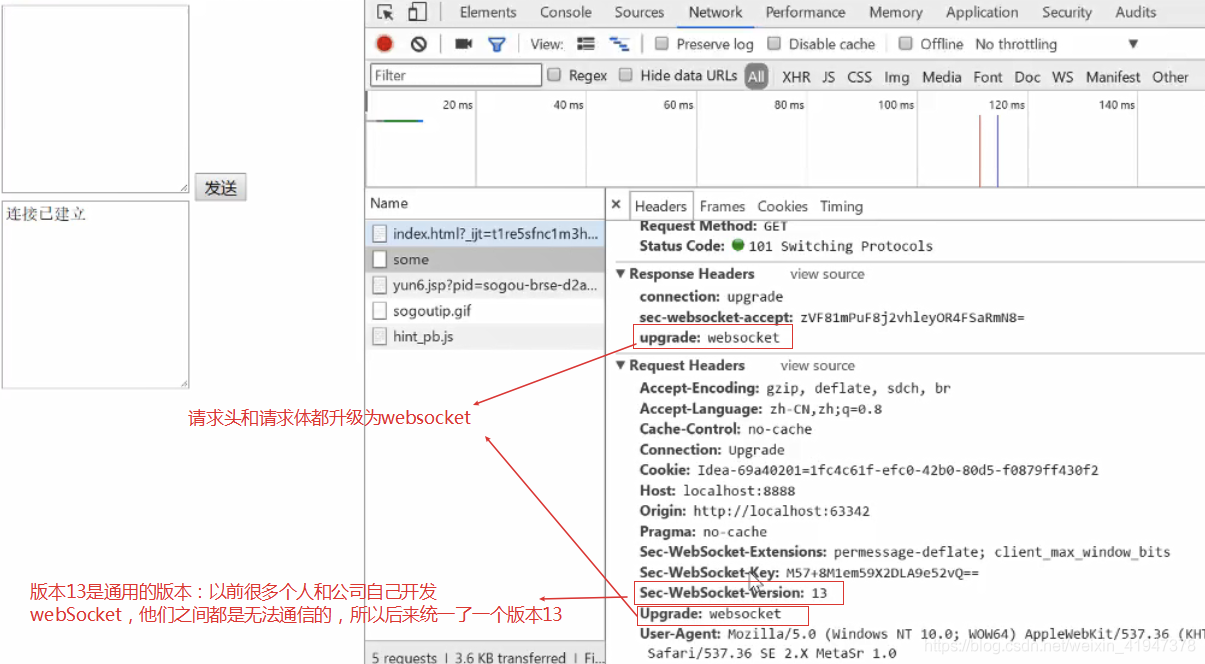
responseHeaders中的sec-websocket-accept和RequestHeaders中的Sec-WebSocket-Key干什么用的?看下WebSokcet握手原理: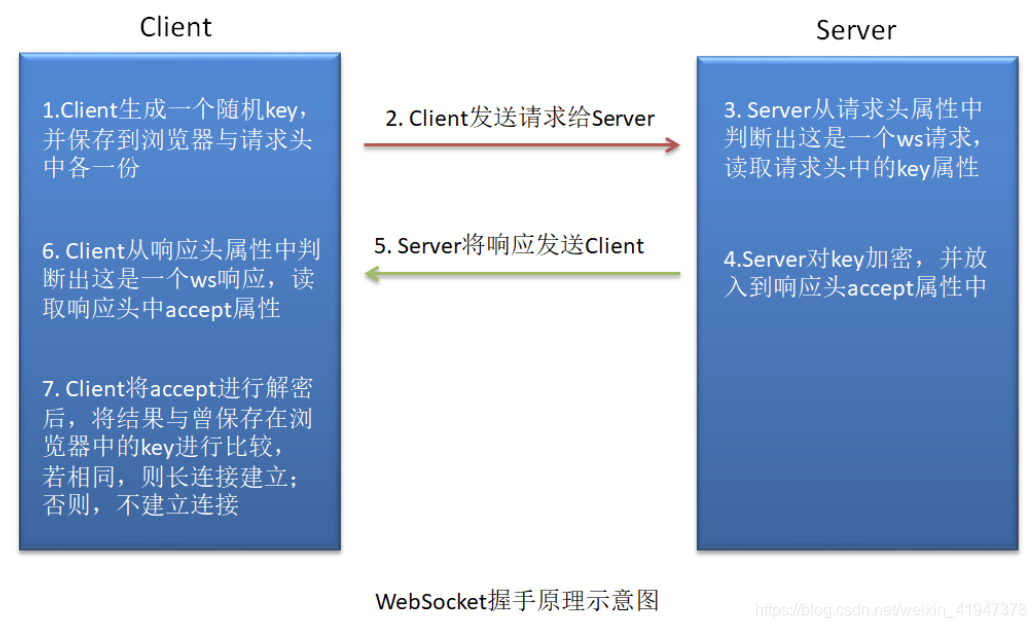
2. 网络聊天
该工程是对 socket 编程的一个应用。
2.1 需求分析
本例要实现一个网络群聊工具。参与聊天的客户端消息是通过服务端进行广播的。
2.2 创建工程 06-webchat
复制 02-socket 工程,在此基础上进行修改:06-webchat
2.3 定义服务端
(1) 定义服务端启动类
添加一个基于行的解码器即可。
public class SomeServer {
public static void main(String[] args) throws InterruptedException {
EventLoopGroup parentGroup = new NioEventLoopGroup();
EventLoopGroup childGroup = new NioEventLoopGroup();
try {
ServerBootstrap bootstrap = new ServerBootstrap();
bootstrap.group(parentGroup, childGroup)
.channel(NioServerSocketChannel.class)
.childHandler(new ChannelInitializer<SocketChannel>() {
@Override
protected void initChannel(SocketChannel ch) throws Exception {
ChannelPipeline pipeline = ch.pipeline();
// 添加一个基于行的解码器
pipeline.addLast(new LineBasedFrameDecoder(2048));
pipeline.addLast(new StringDecoder());
pipeline.addLast(new StringEncoder());
pipeline.addLast(new SomeServerHandler());
}
});
ChannelFuture future = bootstrap.bind(8888).sync();
System.out.println("服务器已启动");
future.channel().closeFuture().sync();
} finally {
parentGroup.shutdownGracefully();
childGroup.shutdownGracefully();
}
}
}
(2) 定义服务端处理器
- A、定义 ChannelGroup

注意:什么是线程驱动?
 EventLoop继承体系:EventLoop -> OrderedEventExecutor ->
EventLoop继承体系:EventLoop -> OrderedEventExecutor -> EventExecutor - B、 重写 channelRead()
可以直接通过group发送给所有的channel
如果希望标明自己,则需要遍历goup,找出自己的channel// 只要有客户端Channel给当前的服务端发送了消息,那么就会触发该方法的执行 @Override public void channelRead(ChannelHandlerContext ctx, Object msg) throws Exception { // 获取到向服务器发送消息的channel Channel channel = ctx.channel(); // 这里要实现将消息广播给所有group中的客户端Channel // 发送给自己的消息与发送给大家的消息是不一样的 group.forEach(ch -> { if(ch != channel) { ch.writeAndFlush(channel.remoteAddress() + ":" + msg + "\n"); } else { channel.writeAndFlush("me:" + msg + "\n"); } }); } - C、 重写 channel 激活与钝化方法
如果激活了,添加到channelGourp,并广播消息通知上线// 只要有客户端Channel与服务端连接成功就会执行这个方法 @Override public void channelActive(ChannelHandlerContext ctx) throws Exception { // 获取到当前与服务器连接成功的channel Channel channel = ctx.channel(); System.out.println(channel.remoteAddress() + "---上线"); group.writeAndFlush(channel.remoteAddress() + "---上线\n"); // 将当前channel添加到group中 group.add(channel); }下线,不需要调用group.remove方法,因为在ChannelGroup里的Channel,如果连接断开了,会自动移除,这个由ChannelGroup自己完成,它会监测所有Channel的状态,一但channel断开连接,马上移除出group
// 只要有客户端Channel断开与服务端的连接就会执行这个方法 @Override public void channelInactive(ChannelHandlerContext ctx) throws Exception { // 获取到当前要断开连接的Channel Channel channel = ctx.channel(); System.out.println(channel.remoteAddress() + "------下线"); group.writeAndFlush(channel.remoteAddress() + "下线,当前在线人数:" + group.size() + "\n"); // group中存放的都是Active状态的Channel,一旦某Channel的状态不再是Active, // group会自动将其从集合中踢出,所以,下面的语句不用写 // remove()方法的应用场景是,将一个Active状态的channel移出group时使用 // group.remove(channel); } - D、重写异常捕获方法
@Override public void exceptionCaught(ChannelHandlerContext ctx, Throwable cause) throws Exception { ctx.close(); }
2.4 定义客户端
(1) 定义客户端启动类
添加一个行解码器,获取键盘输入写入到Channel
public class SomeClient {
public static void main(String[] args) throws Exception {
NioEventLoopGroup group = new NioEventLoopGroup();
Bootstrap bootstrap = new Bootstrap();
bootstrap.group(group)
.channel(NioSocketChannel.class)
.handler(new ChannelInitializer<SocketChannel>() {
@Override
protected void initChannel(SocketChannel ch) throws Exception {
ChannelPipeline pipeline = ch.pipeline();
//添加行解码器
pipeline.addLast(new LineBasedFrameDecoder(2048));
pipeline.addLast(new StringDecoder());
pipeline.addLast(new StringEncoder());
pipeline.addLast(new SomeClientHandler());
}
});
ChannelFuture future = bootstrap.connect("localhost", 8888).sync();
// 获取键盘输入
InputStreamReader is = new InputStreamReader(System.in, "UTF-8");
BufferedReader br = new BufferedReader(is);
// 将输入的内容写入到Channel
future.channel().writeAndFlush(br.readLine() + "\r\n");
}
}
(2) 定义客户端处理器
继承SimpleChannelInbountHandler即可,因为不需要将该数据发出去,用SimpleChannelInbountHandler可以帮我们自动释放掉msg所占的资源
public class SomeClientHandler extends SimpleChannelInboundHandler<String> {
@Override
protected void channelRead0(ChannelHandlerContext ctx, String msg) throws Exception {
System.out.println(msg);
}
@Override
public void exceptionCaught(ChannelHandlerContext ctx, Throwable cause) throws Exception {
ctx.close();
}
}
演示

3. 读写空闲检测
当客户端与服务端的连接建立好后,它们之间就可以进行通信了。但是,若某客户端与服务端间长时间没有进行通信,而 Channel 却被长时间占用,就会形成资源浪费。Netty 提供了专门用于进行读写操作空闲检测的处理器可供使用。
3.1 创建工程 07-idle
复制 06-webchat 工程,在此基础上进行修改:07-idle
3.2 定义服务端
(1) 定义服务端启动类
public class SomeServer {
public static void main(String[] args) throws InterruptedException {
EventLoopGroup parentGroup = new NioEventLoopGroup();
EventLoopGroup childGroup = new NioEventLoopGroup();
try {
ServerBootstrap bootstrap = new ServerBootstrap();
bootstrap.group(parentGroup, childGroup)
.channel(NioServerSocketChannel.class)
.childHandler(new ChannelInitializer<SocketChannel>() {
@Override
protected void initChannel(SocketChannel ch) throws Exception {
ChannelPipeline pipeline = ch.pipeline();
// 添加一个基于行的解码器
pipeline.addLast(new LineBasedFrameDecoder(2048));
// 若在3秒内当前服务器没有发生读操作,则会触发读操作空闲事件
// 若在5秒内当前服务器没有发生写操作,则会触发写操作空闲事件
// pipeline.addLast(new IdleStateHandler(3, 5, 0));
// 若在5秒内同时即发生了读又发生了写操作才不会触发all操作空闲事件
// 若在5秒内读与写操作有任何一项没有发生,都会触发all操作空闲事件
pipeline.addLast(new IdleStateHandler(0, 0, 5));
pipeline.addLast(new StringDecoder());
pipeline.addLast(new StringEncoder());
pipeline.addLast(new SomeServerHandler());
}
});
ChannelFuture future = bootstrap.bind(8888).sync();
System.out.println("服务器已启动");
future.channel().closeFuture().sync();
} finally {
parentGroup.shutdownGracefully();
childGroup.shutdownGracefully();
}
}
}
注意:
- IdleStateHandler 构造需要三个参数:
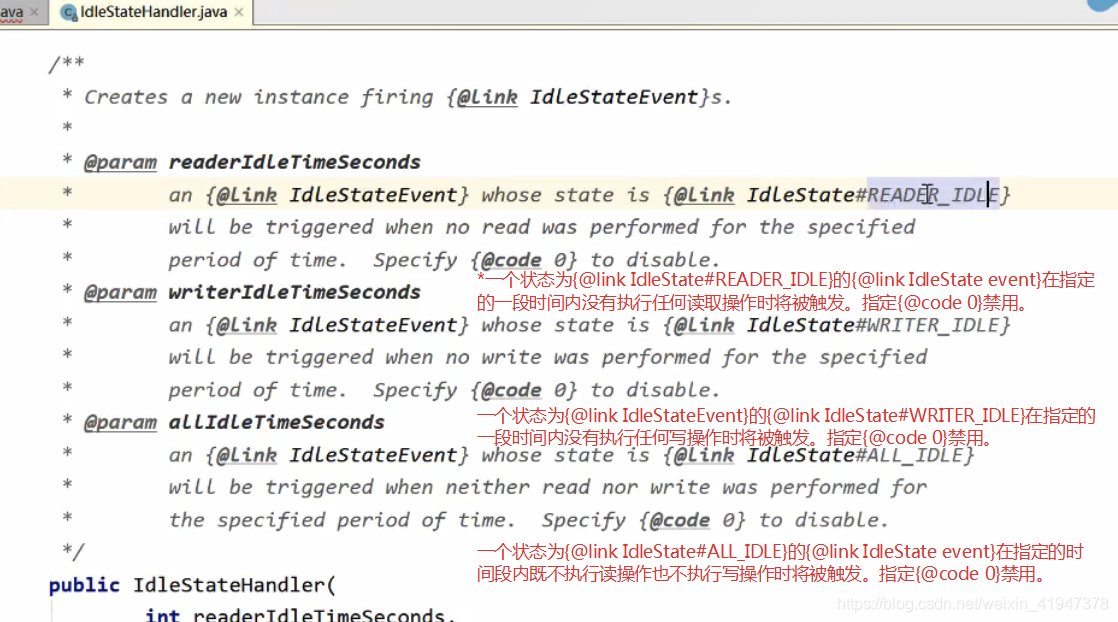
- readerIdleTimeSeconds:在指定时间内没有读操作会触发一个READER_IDLE状态的事件
- writerIdleTimeSeconds:在指定时间内没有写操作会触发一个WRITER_IDLE状态的事件
- allIdleTimeSeconds:在指定时间内没有读或者没有写操作都会触发一个ALL_IDLE状态的事件(
注意是指定时间内读写都发生才不会触发这个事件)
(2) 定义服务端处理器
重写userEventTriggered即可:
@Override
// 所有“规定动作”之外的所有事件都可以通过以下方法触发
public void userEventTriggered(ChannelHandlerContext ctx, Object evt) throws Exception {
if (evt instanceof IdleStateEvent) {
IdleStateEvent event = (IdleStateEvent)evt;
String eventDes = null;
switch (event.state()) {
case READER_IDLE:
eventDes = "读空闲超时";
break;
case WRITER_IDLE:
eventDes = "写空闲超时";
break;
case ALL_IDLE:
eventDes = "读和写空闲都超时";
}
System.out.println(eventDes);
//关闭节点,等于关闭Channel
//我们不用关闭节点,演示效果
//ctx.close();
} else {
//当前处理不了,走默认方法,触发下一个处理器的userEventTriggered方法
super.userEventTriggered(ctx, evt);
}
}
注意:
- IDLE_EVENT事件一旦触发,就会触发Handler的userEventTriggered方法
3.3 定义客户端
直接使用“聊天程序”的客户端即可。
演示
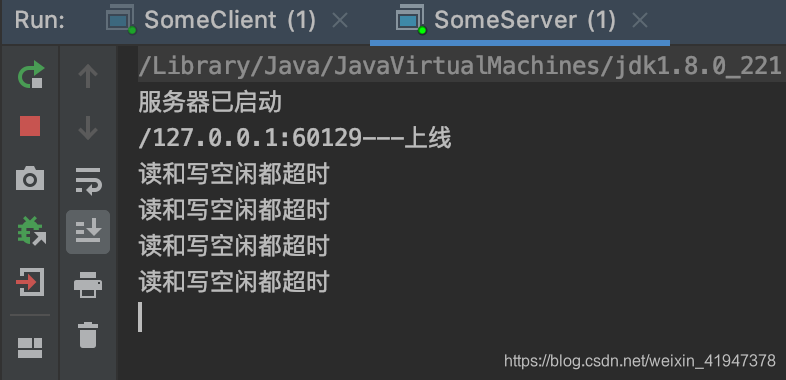
4. 心跳机制
所谓心跳, 即在 TCP 长连接中, 客户端和服务器之间定期发送的一种特殊的数据包, 通知对方自己还“活着”, 以确保 TCP 连接的有效性。
4.1 需求
下面要实现的需求是:Client 端连接到 Server 端后,会循环执行一个定时任务:随机等待几秒,然后 ping 一下 Server 端,即发送一个心跳。当 Server 端在等待了指定时间后没有读取到 Client 端发送的心跳,Server 端会主动断开连接。
4.2 创建工程 08-heartBeat
复制 06-webchat 工程,在此基础上进行修改:08-heartBeat
4.3 定义服务端
(1) 定义服务端启动类
public class SomeServer {
public static void main(String[] args) throws InterruptedException {
EventLoopGroup parentGroup = new NioEventLoopGroup();
EventLoopGroup childGroup = new NioEventLoopGroup();
try {
ServerBootstrap bootstrap = new ServerBootstrap();
bootstrap.group(parentGroup, childGroup)
.channel(NioServerSocketChannel.class)
.childHandler(new ChannelInitializer<SocketChannel>() {
@Override
protected void initChannel(SocketChannel ch) throws Exception {
ChannelPipeline pipeline = ch.pipeline();
pipeline.addLast(new StringDecoder());
pipeline.addLast(new StringEncoder());
//空闲检测读,5秒内没有数据触发读空闲事件
pipeline.addLast(new IdleStateHandler(5, 0, 0));
pipeline.addLast(new SomeServerHandler());
}
});
ChannelFuture future = bootstrap.bind(8888).sync();
System.out.println("服务器已启动");
future.channel().closeFuture().sync();
} finally {
parentGroup.shutdownGracefully();
childGroup.shutdownGracefully();
}
}
}
(2) 定义读操作处理器
public class SomeServerHandler extends ChannelInboundHandlerAdapter {
@Override
public void channelRead(ChannelHandlerContext ctx, Object msg) throws Exception {
System.out.println("接收到Client发送的消息:" + msg);
}
@Override
public void exceptionCaught(ChannelHandlerContext ctx, Throwable cause) throws Exception {
ctx.close();
}
// 用于捕获当前Server中的各种事件
@Override
public void userEventTriggered(ChannelHandlerContext ctx, Object evt) throws Exception {
if (evt instanceof IdleStateEvent) {
IdleState state = ((IdleStateEvent) evt).state();
if (state == IdleState.READER_IDLE) {
System.out.println("将要断开连接");
ctx.close();
} else {
super.userEventTriggered(ctx, evt);
}
}
}
}
4.4 定义客户端
(1) 定义客户端启动类
注意,该类中不能关闭 Channel,不能关闭 eventLoopGroup。
public class SomeClient {
public static void main(String[] args) throws Exception {
NioEventLoopGroup group = new NioEventLoopGroup();
Bootstrap bootstrap = new Bootstrap();
bootstrap.group(group)
.channel(NioSocketChannel.class)
.handler(new ChannelInitializer<SocketChannel>() {
@Override
protected void initChannel(SocketChannel ch) throws Exception {
ChannelPipeline pipeline = ch.pipeline();
pipeline.addLast(new StringDecoder());
pipeline.addLast(new StringEncoder());
pipeline.addLast(new SomeClientHandler());
}
});
ChannelFuture future = bootstrap.connect("localhost", 8888).sync();
}
}
(2) 定义随机发送心跳处理器
一但管道激活,就开始随机发送心跳
public class SomeClientHandler extends ChannelInboundHandlerAdapter {
private ScheduledFuture schedule;
private GenericFutureListener listener;
@Override
public void channelActive(ChannelHandlerContext ctx) throws Exception {
// 发送心跳
sendHeartbeat(ctx.channel());
}
private void sendHeartbeat(Channel channel) {
// 生成一个[1,8)的随机数作为心跳发送的时间间隔
int interval = new Random().nextInt(7) + 1;
System.out.println(interval + "秒后会向Server发送心跳");
//channel.eventLoop().schedule方法可以生成一个定时任务
//该方法有三个参数:需要执行的任务,多长时间以后执行,时间单位
schedule = channel.eventLoop().schedule(() -> {
if (channel.isActive()) {
System.out.println("向Server发送心跳");
channel.writeAndFlush("~PING~");
} else {
System.out.println("与Server间的连接已经关闭");
}
}, interval, TimeUnit.SECONDS);
//该异步定时任务只会执行一次,我们可以添加监听器监听异步任务操作,
//一但异步任务完成马上触发监听器方法,通过监听器可以拿到异步任务的操作结果
//我们可以让监听器一但监听到任务执行完毕,马上重新执行该任务,达到循环的效果
//定义一个监听器,一旦操作完成会触发监听器执行
listener = (future) -> {
// 再次发送心跳
// sendHeartBeat方法执行完了出栈了,才会
// 触发监听的sendHeartBeat,不会栈溢出
sendHeartbeat(channel);
};
// 为定时任务添加监听器,一旦该异步任务结束就会触发监听器逻辑
schedule.addListener(listener);
}
//为了安全起见,重写一个channelInactive方法,当通道被关闭了,
// 就把定时任务的监听器取消掉,就不会再递归调用了,以免通道关闭
// 了,心跳还再一直发
@Override
public void channelInactive(ChannelHandlerContext ctx) throws Exception {
// 一旦连接被关闭,则将监听器移除,这样就不会再发生心跳方法的递归调用了,以防止栈溢出
schedule.removeListener(listener);
}
@Override
public void exceptionCaught(ChannelHandlerContext ctx, Throwable cause) throws Exception {
ctx.close();
}
}
/**
* Listens to the result of a {@link Future}. The result of the asynchronous operation is notified once this listener
* is added by calling {@link Future#addListener(GenericFutureListener)}.
*
* 侦听{@link Future,Future代表异步操作}的结果。
* 一旦通过调用{@link Future#addListener(GenericFutureListener)}
* 添加了该侦听器,就会被通知异步操作的结果。
*/
public interface GenericFutureListener<F extends Future<?>> extends EventListener {
void operationComplete(F future) throws Exception;
}
测试:
不用channelInactive方法,加这也可以一个意思
4.5 客户端重连服务端
(1) 修改处理器
在客户端修改心跳处理器。只需要添加如下内容:
要想重连需要bootstrap,所以我们把bootstrap传到发送心跳的处理器中
public class SomeClientHandler extends ChannelInboundHandlerAdapter {
private ScheduledFuture schedule;
private GenericFutureListener listener;
private Bootstrap bootstrap;
//处理器中传入Bootstrap
public SomeClientHandler(Bootstrap bootstrap) {
this.bootstrap = bootstrap;
}
...
@Override
public void channelInactive(ChannelHandlerContext ctx) throws Exception {
// 一旦连接被关闭,则将监听器移除,这样就不会再发生心跳方法的递归调用了,以防止栈溢出
schedule.removeListener(listener);
System.out.println("重新连接Server...");
//一旦连接关闭,尝试重新连接
bootstrap.connect("localhost", 8888).sync();
}
@Override
public void exceptionCaught(ChannelHandlerContext ctx, Throwable cause) throws Exception {
ctx.close();
}
}
(2) 修改客户端启动类
public class SomeClient {
public static void main(String[] args) throws Exception {
NioEventLoopGroup group = new NioEventLoopGroup();
Bootstrap bootstrap = new Bootstrap();
bootstrap.group(group)
.channel(NioSocketChannel.class)
.handler(new ChannelInitializer<SocketChannel>() {
@Override
protected void initChannel(SocketChannel ch) throws Exception {
ChannelPipeline pipeline = ch.pipeline();
pipeline.addLast(new StringDecoder());
pipeline.addLast(new StringEncoder());
//处理器构造中传入Bootstrap即可
pipeline.addLast(new SomeClientHandler2(bootstrap));
}
});
ChannelFuture future = bootstrap.connect("localhost", 8888).sync();
}
}
测试: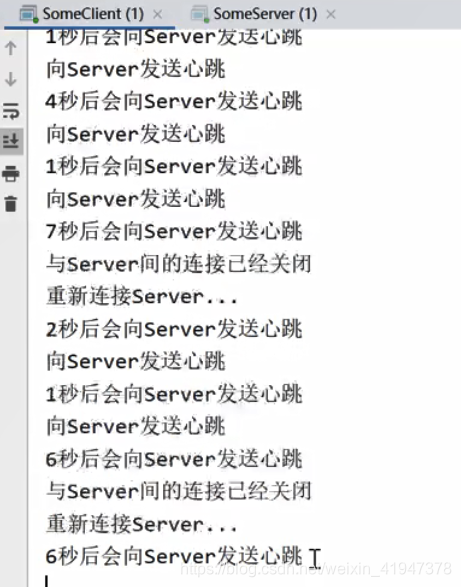
Netty(三)高级应用 之 WebSocket 长连接、网络聊天、读写空闲检测、心跳机制_spring websocket 空闲检测怎么做-CSDN博客




